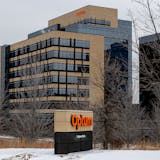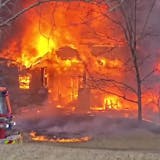Above: From Suhair Barod's Hope and Faith Series, "Hooyo's (mother's) hope" (201), archival inkjet print.
Minneapolis-based Soomaal House of Art collective kicks off its second group exhibition this weekend with an ambitious show spanning three venues in Minneapolis' Cedar-Riverside neighborhood. "Receptacle" opens Saturday at Chase House Community Room (1530 S. 6th St., 2nd floor, Mpls.) with a spoken word performance by poet Muna Abdulahi. The exhibition is concurrently on view at Masjid Dar Al-Hijrah/ICSA (504 Cedar Av. S., Mpls.) and Masjid Shaafici Cultural Center (400 Cedar Av. S., Mpls.) through Aug. 5.
Curated by Minneapolis photographer Mohamud Mumin, "Receptacle" features the work of 13 Somali-American artists: Aziz Osman, Abdi Roble, Ali Halane, Famo Musa, Hodan Essa, Kaamil Haider, Khadijah Muse, Mohamed Hersi, Dr. Mohamed Osman, Mohamed Samatar, Suhair Barod, Tariq Tarey, and the curator himself, Mohamud Mumin. Half are from Minnesota and the others from locations around the U.S. The show is substantially larger than the group's inaugural exhibition, 2016's "Anomalous Expansion," which featured just six Somali-American artists, all from Minnesota. We caught up with Mumin to ask about the show, the work and the meaning behind mounting an art exhibition at a mosque. The conversation has been lightly edited for length and clarity.
Q: Why is the show named "Receptacle"? What is the meaning behind that?
A: It's sort of like, we were thinking about building off of last year's exhibition, "Anomalous Expansion," I suppose we wanted to think about the space a lot more. And to have this experience being more than just people coming in, looking at artwork, but to be more engaging, to engage with the artist. As you can see from our programs, we have something going on every week with our artists. So we were thinking about in a sense, the space itself, thinking about also the receptacle being the thing that you put things into – if you were thinking about a container, each artist being able to contribute, chip in their ideas through their work into these receptacles, and in the process the audience can also take something away from it being that it is the first time something like this has been done in the West Bank by Somali artists.
Q: What was the inspiration for the show?
A: The inspiration for the show also goes hand-in-hand for the inspiration of the collective, the idea being moving from this space where you are presenting content and not having a say in terms of what it needs to be and where it needs to go. The artists in this show have had institutional shows, too. So for this show we wanted to be in control – we wanted to center the narrative. We know this work more than anybody else and we know the community, so we wanted to only depend on ourselves rather than be at the mercy of institutions where sometimes the space is limited and pre-determined and the theme is set. We wanted to move away from that.
For the collective and these exhibitions, that's what it came down to. And funding. For the first show, "Anomalous Expression," it was more like, [making it happen] by any means necessary, but it's morphed into its own thing now. People were asking after that first show, when is the next one? When can we see? How it came about was that, we needed to build on the momentum and engage. So building the audience also goes hand in hand with the show's conceptual framework, and teaching in some ways — I always like to say that we wear many hats, one of them is to make critical work, and at the same time teach. So we are constantly – and mostly in our own communities first, and then outward.


